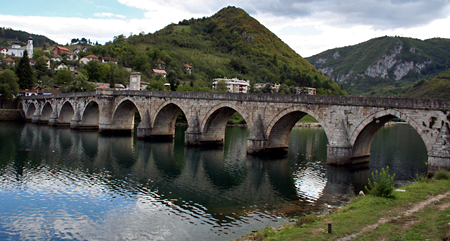One of the main news items in the Bosnian blogosphere this week has been the addition of the Višegrad stone bridge to UNESCO's World Heritage List. The bridge, named after Mehmed Paša Sokolović, one of the most famous Grand Viziers of the Ottoman Empire, born in Višegrad in 1505, connects the two banks of the Drina River, which forms most of the border between Bosnia and Serbia. Bosnian writer Ivo Andrić, who received the Nobel Prize for literature in 1961, wrote a book called The Bridge over the Drina River, which described the building of the bridge and life in Bosnia under the Ottoman Empire.

Mehmed Paša Sokolović Bridge, Višegrad, Bosnia and Herzegovina by Wodnerduck”, used under a Creative Commons license.
Day and Night, who posted a couple photos of the bridge, describes it as a masterpiece:
Characteristic of the apogee of Ottoman monumental architecture and civil engineering, the bridge has 11 masonry arches with spans of 11m to 15m, and an access ramp at right angles with four arches on the left bank of the river. The 179.5 m long bridge is a representative masterpiece of Sinan, one of the greatest architects and engineers of the classical Ottoman period and a contemporary of the Italian Renaissance, with which his work may be compared. The unique elegance of proportion and monumental nobility of the whole site bear witness to the greatness of this style of architecture.
The Bosnia News blog reports that on March 25th UNESCO Director Koichiro Matsuura presented the Bosnian authorities with a certificate on the listing of the bridge in a ceremony in Sarajevo, recognizing its “outstanding universal value.” However, Bosnia News explains that:
UNESCO Director Koichiro Matsuura's visit to Visegrad was canceled “for security reasons”. The organizers of the event decided not to hold the ceremony on the bridge after the Bosnian Association of Women Victims of War announced plans to put a plaque on the bridge commemorating genocide victims from Visegrad at a ceremony that was to have coincided with the certificate-awarding ceremony.
Members of this Bosnian association put the plaque on the bridge and read out the names of 3,000 genocide victims from Visegrad.
The Mehmed Paša Sokolović Bridge is the second monument in Bosnia that UNESCO has recognized, after the Old Bridge in Mostar. About the Mostar Bridge, the blog Balkan Cities reported that “a ‘chink’ (a crack?) has appeared on Mostar's Stari Most (Old Bridge). Previously, UNESCO had forced Bosnian authorities to stop the construction of a hotel near the structure by threatening the country with the removal of the bridge from the World Heritage List.”
Speaking of the Mostar Bridge, the Italian-language blog Balkanscapes, which is devoted to the restoration of buildings destroyed during the 1990s Yugoslav wars, recently analyzed the significance of the new Old Bridge. This is how he describes the construction of the original bridge, which was destroyed in 1993:
Fortemente voluto da Solimano il Magnifico, venne realizzato nel 1556, in nove anni, dal geniale architetto Miram Hajruddin, il quale, ben consapevole delle difficoltà tecniche di realizzare un ponte di quelle dimensioni con un'unica arcata, e temendo l'ira di Solimano, che gli aveva promesso la morte in caso di crollo, preparò il suo stesso funerale per il giorno in cui sarebbero state tolte le impalcature. Il ponte non crollò, e per secoli rappresento il simbolo della convivenza tra etnie diverse, cattoliche/croate, musulmane/bosniache, ortodosse/serbe. Quel ponte fu, per secoli, la vera e più autentica porta verso l'Oriente.
Intensely wanted by Suleiman the Magnificent, it was finished in 1556, in nine years, by the brilliant architect Miram Hajruddin. Being aware of the technical difficulties to build a bridge of those dimensions with just one arch, and fearing the anger of Suleiman who had threatened him with death if it collapsed, the architect prepared his own funeral for the day in which the scaffolding would be removed. The bridge didn't collapse, and for centuries it has been a symbol of the cohabitation of diverse ethnic groups, catholics/Croats, muslims/Bosniaks, orthodox/Serbs. That bridge was, for centuries, the true and most authentic door towards the East.
However, he doesn't think that the current bridge, which re-opened in 2004 after years of reconstruction, has kept the same spirit of uniting the peoples of Mostar:
Ma quel ponte, che per secoli ha unito i quartieri croati a quelli musulmani della città, che per secoli è stato luogo di transito, di passaggio, di comunicazione […], ora sembra aver incorporato un'invisivile barriera. Da soglia tra due anime della città, così dicono in tanti, esso sembra ora essere un limite invalicabile.
But that bridge, which for centuries united the Croat and the Muslim quarters of the city, which for centuries has been a place of transit, of passage, of communication, now seems to have incorporated an invisible barrier. The threshold between two souls of the city, as many say, now seems to be an impassable boundary.
The post has several comments on the new Old Bridge, and one of them, by cicciosax, says that it “has become an ethnic symbol of the Muslims which, as it was to be expected, has been rejected by the Catholics, who erected a gigantic cross to confront it.”
Now a new cross, to be erected in Sarajevo as a memorial to the Serbian war victims, is causing discomfort in the city. Samaha explains why such a memorial would be offensive to most Sarajevans and why she is against the idea:
You and I know that when that memorial is viewed from the city, that when that memorial is pointed out, the reference that will be made to it is “that is the spot from where some of the deadliest attacks were cast upon our city”. I sincerely hope that this memorial does not go up because as I stated before the memorial will not serve the purpose of honoring the dead it will serve as a landmark of aggression and ethnic cleansing and to place a cross on that spot is neither a service to God or man but if the Serbs choose to honor their dead in this way then let them.
YakimaGulagLiteraryGazett also dislikes the idea of the cross memorial:
I think that kind of memorial has more in common territorial pissing or flipping the bird than it does with anything to do with religion. […] Most Muslim memorials to the war are of very modest dimensions, and even most Croat memorials are smaller. I find crosses of this type VERY un-Christian frankly.
And she wonders:
why don't these people help Serbian war survivors? Why don't they help the injured people from their side?






